We’ve fallen and can’t get up!
A new patient was referred to me by a local periodontist. She’s in her 70s. Her husband fell down, and in the process of helping him, she fell on her face and fractured porcelain on teeth #9 and #10. They are part of a larger bridge, #6 – #14. Teeth #s 8, 10, and 12 are pontics. Teeth #s 7 and 9 aren’t so hot, as you can see.
The patient and her husband were due to return home (up north) for the summer. Her husband is still in the hospital.
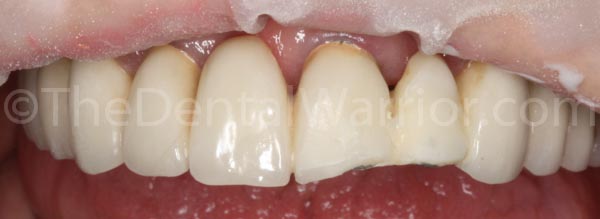
Porcelain fractured down to the metal on the incisal.
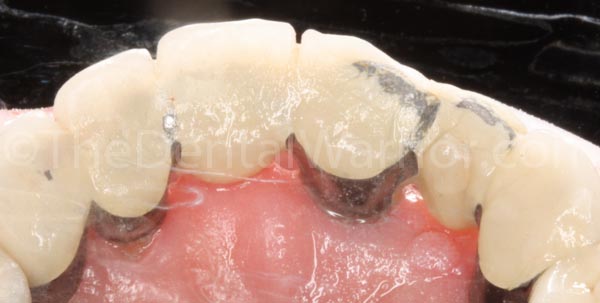
Metal is visible on the incisal edge and lingual. Apologies for the poor quality photo (scratched mirror).
Plan A, Plan B, Plan C
Treatment options discussed included:
- Sectioning the anterior segment of the bridge, placing two implants and a four-unit bridge 7 – 10.
- “Overcrowns” #’s 9 and 10.
- Composite repair.
Certainly, we could argue that an implant reconstruction would be the “best” and most predictable. However, sectioning bridges and leaving abutments intact can be fraught with pitfalls such as porcelain fracture and metal exposed in the wrong places.
Overcrowns work great in the right situations, especially over pontics. But, not so much over existing crown abutments.
Finally, there is doing a composite repair. Sometimes they work great. While bonding to porcelain (and metal) is more predictable today than years ago, it’s not something we can count on consistently.
Sometimes, Plan C is best… for now.
Given the complexity (time, money, etc.) of the implant option, and her current “life situation” with her husband in the hospital, we agreed that attempting to repair with composite would be the best fit for now.
I did not have time to take step-by-step photos of this case. But, I will briefly describe how I went about it.
I isolated with an Optragate. I used a diamond to lightly “prep” the remaining porcelain and then used an intraoral “sandblaster” to create a good bonding surface. I then used Apex Dental Materials’ Interface (combination of porcelain etch and silane) and applied to the prepped porcelain for one minute. Then dried (not rinsed). Next, I applied 3M’s Scotchbond Universal bonding agent. After that, I opaqued the exposed metal with some white composite tint (I can’t recall the brand at the moment). Then I built up the “dentin” with a dentin shade composite (3M’s Filtek Supreme Ultra). After that, I added body shade composite to full contour. Polished it up, and “off you go.”
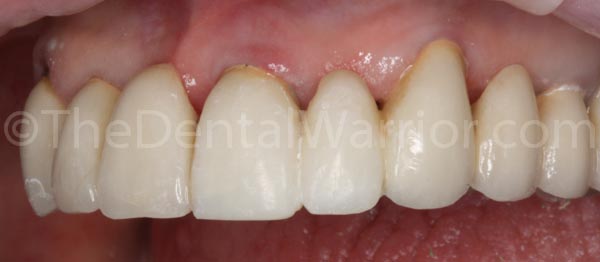
Final result #9 and #10.
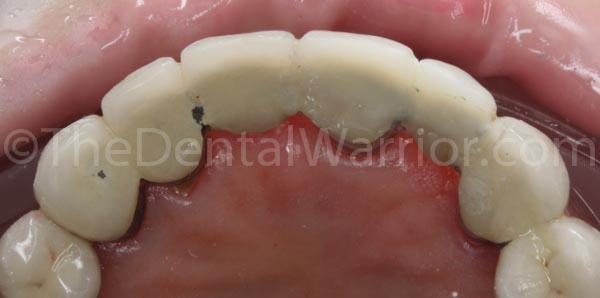
Occlusal view of repair.
Your mileage may vary.
This was an economical and quick solution to her immediate dental issue. And, it didn’t take her away from tending to her husband. She was very happy with the result.
An implant reconstruction would have been “best” for both the patient and my revenue “production.” So, I’m not the best “businessman.” But, I really believe this was a practical approach, given her immediate “life circumstances.” And, I believe it will serve her well.
She understands that it may not last, and it may need to be redone. However, she remarked, “I could have this redone many, many times and still spend much less than for the implants.” I explained that implants may be in her future, nonetheless.
What is your experience with composite repairs like this? Comment below!
 Copyright protected by Digiprove © 2014 The Dental Warrior®
Copyright protected by Digiprove © 2014 The Dental Warrior® 

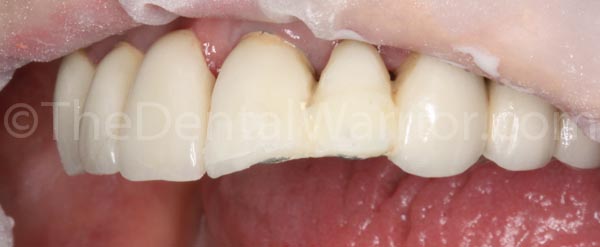
I have a similar situation coming up in a few weeks but it is an Emax bridge place less than a year ago. Options are fix or replace. I am going for repair with Apex materials. Hoping I get some good milage out of it.
Thanks for your postings.
Kevin
Thanks, Kevin. Good luck with it!
My father did a implant supported bridge over 10 years ago and the porcelain chipped on #8 (I checked and she is still in CR, after all of these years, wow, go dad!). Lab, his occlusion, normal wear and tear? I dunno. But I can tell you I did have a hell of a time figuring out how to tie on the rubber dam around all of the implants (good thing sewing is a hobby, because I did figure it out). Anywhoo….I did something similar. Beveled. HF acid (porcelain etch). Silane. And yes Scotchbond Universal! I usually am a 5th gen lady, but every once in awhile I like the new stuff. Filtek Supreme Ultra as restorative material. It is still holding after more than a year (knock on wood!!!!). I could always remake the bridge at some point, but I usually try to stay conservative (if possible).
Thanks, Ellie, for your comments and experience! Have you tried the “split dam” technique? Here are a couple of examples:
Also, the Optragate and Isolite come in quite handy for a variety of situations.
Wondering what the Teflon tape is for …..
Hi Gloria. The teflon tape was used to cover the preps on the canines, so I could etch, bond, and cement the anterior four restorations without getting any of those materials on the canines (that could prevent full seating of the canine restorations to be cemented separately).
Do you always use two clamps for anterior split dam?
As opposed to? Not sure if I’m following. 🙂
I think you may be referring to wedgets instead of clamps, or you could always tie it off with floss. Thanks Dr. Mike I have tried the split dam and occasionally I use it….except when I have HF acid on board. I am terrified of getting that on the gingiva so I use full coverage and sometimes even supplement with liquid rubber dam. Thanks for your service this holiday weekend. My husband and father were both Army 🙂
Those were great choices you gave her Mike and you got a great result. At her point in life this may be the last time she has to worry about these. For me these type of repairs are no more than a 50-50 proposition. Don’t seem to give me a lot of predictability and after a while the aggravation of repairing them at inopportune times(and there really never is an opportune time for a front tooth to chip) for the patient will finally motivate them and I to move on to something more predictable. that being said I would have done just what you did to see how it works.
As they say on the radio talk shows, long time listener first time caller, enjoy your writings. Have a great weekend.
Thanks for chiming in, Pat! Here’s another case I did 3-1/2 years ago. Still going strong.
Good job. Given the circumstances, this was a great way to go.
I did porcelain repair on #10 couple of years ago, seems to be holding up well.
Mike: In reading some recent bonding literature from BISCO, (in which they compare leading universal bonding agents), it was my understanding that ScotchBond Universal CONTAINS silane.
If that is true, why do you so the additional silane step?
Hi Michael. I honestly don’t know if SBU has silane in it. I don’t recall hearing that (even when I was at 3M up in Minneapolis when they launched it). But, it doesn’t mean it’s not the case. Either way, I’d need to etch the porcelain, and Interface combines porcelain etch and silane.
Also… Silane is very unstable once it’s mixed and doesn’t last long. That’s why Apex keeps the components of their silane product (Interface) separate (you mix them when ready to use).
It seems that SBU does contain silane, but as you say, it seems to be unstable and have a low water contact angle compared to pure silane primer. Why then 3M would include silane in SBU, I’m not sure.
PS: It would be nice if your blog could flag us when there is a response!
You should be able to subscribe to a post. Look below the “Post Comment” button and there are some options there.
A must say, that’s a really nice result you’ve got in this case, and to be honest probably the pragmatic treatment plan option given the patient’s family circumstances. The patient left happy, so result.
I’ve tried some similar cases with 3M ‘s co jet system and admit the results have been mixed. But as a short to medium term solution it works!
wow – that is a total nightmare. Falling and busting up so many teeth like that – I can only imagine how freaked out they must have been.
Looks like a good repair job though, props!
The poor couple, that’s a lot to deal with all at once! Looks like you went with the best option though.